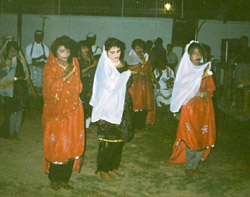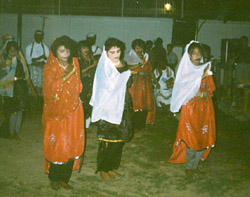
Folk Dance… A Reflection of The Day-to-Day Life [Archives:2001/39/Culture]
September 24 2001

Different kinds of dance prospered in Aden. The many foreign communities that settled in Aden helped contribute to the variety of dances in this beautiful city. It is said that some of the folk dances are a mixture of Indian, Somali and other flavors.
People of Wadi Hadhramaut recognize about 46 dances all over the governorate. The great number of dances may, to some extent, be attributed to the vastness of the city. Mirikoz, Sahrh Addan, Sharh Azzarbadi, Al-Hinaa, Baraa, are some of those popular dances in the city.
However, there are a number of dances which are no longer practiced, such as those expressing the life and work of fishermen. These vanished dances date back to the pre-Islamic period, when Yemenis worshiped many Gods. One of these dances is called ‘Assuban’, which, in fact, was the name of the God of the Sea.
In Shabwa, dances vary as the topographic relief of the city. Some kinds of dance are confined to those inhabiting the mountains, while others are practiced by inhabitants of the coast. Some dances are related to occasions such as wars. One of these is ‘Assakrah.’
Despite the modern aspects of technology, all folk dances are still performed in the company of primitive instruments such as drums and pipes.
In Al-Maharah, there are some dances which are performed by a single dancer and others which are performed by more than one. Similar dances are performed elsewhere in the neighborhood but the names are different.
There are many dances in which both men and women together dance to the beats of drums, especially on happy occasions such as wedding ceremonies.
All kinds of dance in Yemen seem to be a reflection of the day-to-day life or the surroundings. This may explain the secret of the continuation of these kinds of dances until the present time.
——
[archive-e:39-v:2001-y:2001-d:2001-09-24-p:./2001/iss39/culture.htm]


